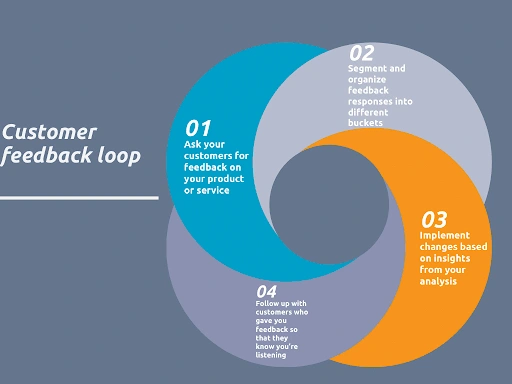How to Gather Customer Feedback to Enhance Products and Services

SaaS companies can expect to increase revenue by $1 billion within 3 years of investing in customer experience.
We can’t stress the importance of a great customer experience. Instead of providing your customers with “what you think they want”, why not ask them “what they actually want”?
How?
Through customer feedback.
Collecting customers' feedback isn't as simple as taking a stroll in the park because customers can often be hesitant to fill out surveys or participate in reviews.
In this article, we will look at ways to improve products and services using customer feedback.
What is Customer Feedback?
Customer feedback is the insights customers share about their experiences with your products or services.
Who better to share knowledge about your company’s products and services than their users?
Customer feedback provides a roadmap for improvements, helping you understand what resonates with your customers and where there might be opportunities to enhance their overall satisfaction.
Why is customer feedback important?
More than 60% of customers say they now have higher customer service standards, which means their expectations are higher now than ever before.
According to Dave Pabley of Qualtrics, “Customer expectations are a set of ideas about a product, service or a brand that a customer holds in their mind.” Simply put, your customers have certain expectations that you need to fulfill to satisfy them.
One of the main benefits of customer feedback is the direct insights into how your customers experience your products or services. This helps you understand their perspectives, pain points, and delights. Once you understand your customers, fulfilling and satisfying their expectations becomes a breeze.
What are the Reasons for Collecting Customer Feedback?
Collecting customer feedback for your SaaS company is essential because it helps you understand:
Your customers’ experience
Customer feedback provides direct insights into your customers’ experiences with products or services. By understanding what works well and what doesn't, your SaaS business can enhance positive experiences and address areas causing dissatisfaction.
Their specific preferences
Customers express their likes and dislikes, offering precise information on features or aspects that resonate with them or need improvement. This data will help you tailor your SaaS to meet customer preferences more effectively.
Their unmet needs
Collecting feedback helps you identify where you fall short of meeting your customers’ expectations. Meeting or exceeding these expectations builds trust, customer satisfaction, and loyalty. It also influences pricing strategies, ensuring they align with what customers value.
Their behavior
Analyzing feedback trends gives SaaS companies a deeper understanding of how customers interact with their services. This insight helps identify what attracts customers to the business, prevents conversions, and influences them to engage or convert.
Difference between feedback and improvement
Feedback is information in response to a product or service, often expressing opinions or experiences. Users often provide feedback. Product improvement, on the other hand, involves making changes to enhance a product's quality, features, or performance based on received feedback to deliver a better overall experience to users.
Feedback serves as the input, while product improvement is the outcome achieved through iterative enhancements.
Choosing the Right Feedback Channels
To get customer feedback, you can employ various methods such as:
Online surveys and questionnaires
Online surveys are a great method of collecting feedback so SaaS companies can measure customer satisfaction, conduct market research and understand their expectations.
They help gather real and concrete customer information instead of working off assumptions. This brings problems you might not even know exist or hamper your product or service.
You can check out the article “Types of Surveys and When to Use Them.” It looks into the different types of surveys, from NPS to CSAT and CES, that can be used to get direct feedback from your customers.
In-person feedback
In-person feedback is ideal for in-depth discussions, especially in complex situations, and enhances personalized services like consulting.
It builds personal connections, fostering customer, client, or employee relationships. In-person interactions are invaluable for real-time insights into behaviors or product usage. They're suitable for sensitive matters, ensuring privacy and trust.
In-person discussions are important for quick decisions or hands-on product feedback. They are also effective for employee evaluations and positive work environments. Participant feedback is immediate at events or trade shows.
Social media and online reviews
Sproutsocial shows that 47% of customers complaining about your product or service will voice their concerns on social media. Use social media for real-time interactions and a diverse audience reach. Encourage customer experiences through posts and reviews, generating valuable user-generated content.
You can also use it during product launches for feedback and engagement. Build a community for loyalty and constructive feedback. Actively monitor reviews, share surveys, and analyze competitor insights.
Showcase positive feedback as marketing assets. social media for creative ideas and promptly address negative feedback or crises, demonstrating transparency and commitment to resolution.
Feedback forms on your website
Use feedback forms post-purchase, strategically on your website, and after customer support interactions to gather insights. For website usability, design, and content relevance. Include forms in event or webinar feedback, newsletters, and subscription models. Gather feedback before new feature releases and at key stages of lead generation.
Tailor forms to demographics and employ them consistently for an ongoing strategy of continuous improvement.
Strategies for Effective Feedback Gathering
While feedback gathering is great for understanding your customers’ needs and expectations, the first hurdle is ensuring that your customers give you feedback - not just churn.
In this section, we’d be covering some strategies to ensure that you get meaningful insights from your customers:
Set clear objectives
The issue with many feedback-gathering sessions is that they try to get all the information they can at once. This is not a good option because you’d bore your customers, and they’d probably opt out before you get to the third question.
You need to articulate the goals and objectives of your feedback process. Understand what specific information you aim to gather to guide the design of your feedback collection methods.
For example, If your objective is to enhance the user experience on your website, your feedback questions should be designed to gather insights specifically related to navigation, content relevance, and overall satisfaction.
Good to know: A clear objective makes it easy for your customers to respond and ensures that the feedback you receive aligns with your improvement goals.
Create clear, straight-to-the-point questions
Ask questions that are clear, concise, and directly related to your objectives.
Instead of asking a vague question like "How was your experience?" Be specific. For instance, "On a scale of 1 to 10, how would you rate the ease of finding information on our website?"
Clear questions help respondents provide focused and actionable feedback, making it easier for you to analyze and implement changes.
Encouraging open and honest communication
Create an environment where customers feel comfortable providing honest feedback. Assure anonymity if necessary and emphasize that constructive criticism is valuable for improvement.
A Harvard Business Review study showed that "over 69% of people try to avoid communicating negative information, and 37% will not give critical feedback at all."
Include a statement in your survey assuring respondents that their feedback is valuable and will be used to enhance the customer experience. You might say, "We appreciate your honesty, and your feedback will help us improve our services. Your responses are confidential." This reassures customers and encourages them to share both positive and constructive feedback.
Analyzing and interpreting feedback
It’s one thing to get customer feedback; it’s another to properly analyze and interpret the feedback data and plug the missing data gaps to create a great experience. In this section, we’d be going over how to analyze and interpret feedback in three steps:
Collection and organizing feedback
The most important part of feedback analysis is collecting the feedback. We already spoke about how to collect feedback in the former sections (so we don’t have to go back to that).
Once you have your customer feedback, you next must collate all the feedback you want to analyze into a spreadsheet. The spreadsheet will include customer feedback, feedback type, submitted date, and customer ID.
Then, you organize the feedback. You can organize feedback into categories based on common feedback types, themes, or topics. Use tags or labels to group similar feedback together.
Below are some categories for a SaaS:
Billing/Pricing issues
Bug issues
Feature requests
Positive/negative reviews
App usability issues
Miscellaneous
Identifying trends and patterns
Once you’ve collated and categorized customer feedback, you should next identify trends and patterns. This helps businesses understand customer pain points, areas for improvement, and potential opportunities.
You can identify trends and patterns in your feedback through these methods:
Qualitative Analysis
Analyze open-ended feedback for recurring phrases, keywords, or sentiments pointing to common issues (similar to categories seen above).
Segmentation
Break down feedback by customer segments, demographics, or product categories to identify patterns specific to certain groups.
Timeline Analysis
Analyzing trends over time can reveal patterns linked to product releases, marketing campaigns, or changes in business operations.
Prioritizing feedback for action
The third and final step is to make improvements based on the insights gained from the analysis process. Use this insight to make informed decisions, improve customer experience and drive continuous improvements.
Implementing changes based on customer feedback
To implement changes based on customer feedback, you need to follow a certain process, as listed below:
You have to review feedback, prioritize changes based on significance, and create a clear action plan
Collaborate with teams, communicate changes internally and to customers
Implement changes, monitor impact and keep an active feedback loop for continuous improvement.
Document successes, train employees, and stay adaptable to evolving customer needs
Prioritizing feedback and identifying key areas for improvement
Every piece of feedback is important, but how do you prioritize the ones you’d focus on? After you’ve organized and categorized your feedback based on types or themes, you can prioritize them by following these steps:
Determine how significantly each category affects the overall customer experience or your key business metrics.
Evaluate how each category aligns with your business goals and objectives.
Prioritize categories directly impacting achieving your business goals or improving key performance indicators.
Also, seek input from employees.
For example, a SaaS business may categorize feedback into billing/pricing, technical, feature requests, app usability, and miscellaneous issues. If the company aims to increase expansion revenue and retain customers, then focusing on technical and app usability issues might be the first priority.
Why? Because if customers don’t have a good in-app experience, they’ll churn.
Iterate product development based on customer input
Once improvements have been implemented based on customer feedback, communicate these changes to your customers. It doesn’t end there. Keep asking for their feedback and keep refining, enhancing and evolving a product/feature through continuous cycles of customer feedback.
The Continuous Cycle of Gathering and Implementing Custom
The continuous cycle of gathering and implementing customer feedback involves obtaining insights, making improvements, and iterating.

Customer feedback loop
Continuously gather feedback from customers through surveys and interactions. Analyze and prioritize this feedback, then set clear goals for improvements. Make a detailed plan, involve different teams, and implement changes.
Test and monitor the impact, gather more feedback on these changes, and learn from the process. Communicate openly with customers about updates.
In a continuous cycle of improvement, keep iterating regularly, adapting to market changes, training employees as needed, and celebrating successes.
Wrapping up
There, you have it -exactly how to gather customer feedback to improve your products and services. Customer feedback is essential for continuous improvement for any SaaS company. Embrace the feedback loop—collect, analyze, act, and iterate. Don’t miss the opportunity to turn customer insights into actionable strategies that drive growth and satisfaction. Start improving your customer experience today!
Like this project
Posted Jun 2, 2024
A detailed guide for SaaS/Tech companies on using customer feedback to improve their products and services.
Likes
0
Views
32





